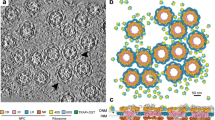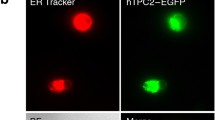Abstract.
The nuclear hourglass technique (NHT) was recently introduced as a novel technique that measures the electrical nuclear envelope (NE) conductance of isolated Xenopus laevis oocyte nuclei. The main conclusion drawn from NHT work so far is that nuclear pore complexes (NPCs) of oocytes are in an electrically open state under physiological conditions, with a mean conductance of 1.7 nS per NPC. Since nuclear patch-clamp data indicate that usually NPCs are electrically closed, our work has been challenged by the notion that NHT cannot assure a high resistance seal (``gigaseal'') between glass wall and NE like that required for patch-clamp experiments. Thus, NHT could have dramatically underestimated NE electrical resistance. Here we demonstrate that NHT does not require a gigaseal for accurate NE conductance measurements. In addition, we present experimental conditions where mean single NPC electrical conductance is reduced 26-fold due to electrophoretic plugging by negatively charged nucleoplasmic macromolecules. In addition, data indicate that under physiological conditions (i.e., when macromolecules are offered in the cytosolic solution) the nuclear surface is heavily folded, underestimating ``true'' NE surface by a factor of 2.6. When ``true'' NE surface area is taken into consideration, modified values of mean single NPC conductances of 654 pS for electrically open conditions and 25 pS for electrically plugged conditions can be calculated.
We conclude that the large overall NE conductance detected with the nuclear hourglass technique in intact Xenopus laevis oocyte nuclei can be explained by the sum of single NPC conductances in the pS range, as long as open probability is high. This confirms previous patch-clamp work concerning single NPC conductance, but disagrees with the view that mean open probability of NPC channels is usually low.
Similar content being viewed by others
Author information
Authors and Affiliations
Additional information
Received: 27 March 2001/Revised: 3 July 2001
Rights and permissions
About this article
Cite this article
Danker, T., Shahin, V., Schlune, A. et al. Electrophoretic Plugging of Nuclear Pores by Using the Nuclear Hourglass Technique. J. Membrane Biol. 184, 91–99 (2001). https://doi.org/10.1007/s00232-001-0078-1
Issue Date:
DOI: https://doi.org/10.1007/s00232-001-0078-1




